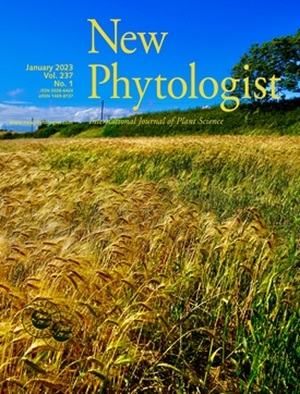Endodermal lignification coordinates with root calcium levels to govern lateral root emergence
IF 8.3
1区 生物学
Q1 PLANT SCIENCES
引用次数: 0
Abstract
- Calcium (Ca), an essential macronutrient, is crucial for the growth of young plant tissues, including the formation of lateral roots (LRs) that originate from pericycle cells in the inner root. The Casparian strip (CS) serves as an apoplastic barrier in the root endodermis, optimizing nutrient transport and facilitating plant adaptation to various environments.
- This study demonstrates that the integrity of the CS regulates local Ca-dependent LR emergence by controlling the lignification of the overlying endodermal cells in Arabidopsis.
- In mutants with disrupted CS integrity and compensatory lignin deposition, plants require sufficient Ca to maintain auxin gradients and the morphology of LR primordia, thereby promoting LR primordia through the endodermis. Both piperonylic acid treatment and genetic evidence indicate that excessive lignification of the overlying endodermal cells significantly delays LR emergence under low-Ca conditions compared with sufficient Ca. The receptor-like kinase SGN3/GSO1 mediates this excessive lignification. Importantly, the function of the CS in LR emergence is independent of Ca translocation from roots to shoots and, consequently, shoot growth dynamics.
- Overall, our study highlights the direct involvement of CS integrity in modulating Ca-dependent LR emergence by controlling cell wall stiffness through the lignification of overlying endodermal cells.
内胚层木质化与根钙水平协调,控制侧根的萌发
钙(Ca)是一种必需的常量营养素,对幼嫩植物组织的生长至关重要,包括起源于内根中柱鞘细胞的侧根(LRs)的形成。Casparian strip (CS)作为根内胚层的外质屏障,优化养分运输,促进植物对各种环境的适应。本研究表明,CS的完整性通过控制拟南芥上覆内胚层细胞的木质化来调节局部Ca依赖性LR的出现。在CS完整性被破坏和补偿性木质素沉积的突变体中,植物需要足够的Ca来维持生长素梯度和LR原基形态,从而通过内胚层促进LR原基。胡椒酰酸处理和遗传证据都表明,在低钙条件下,与充足的钙相比,上覆内皮细胞的过度木质化显著延迟了LR的出现。受体样激酶SGN3/GSO1介导了这种过度木质化。重要的是,CS在LR萌发中的作用与Ca从根到茎的转运无关,因此与茎的生长动态无关。总的来说,我们的研究强调了CS完整性通过上覆内皮细胞的木质化来控制细胞壁刚度,从而直接参与调节Ca依赖性LR的出现。
本文章由计算机程序翻译,如有差异,请以英文原文为准。
求助全文
约1分钟内获得全文
求助全文
来源期刊

New Phytologist
生物-植物科学
自引率
5.30%
发文量
728
期刊介绍:
New Phytologist is an international electronic journal published 24 times a year. It is owned by the New Phytologist Foundation, a non-profit-making charitable organization dedicated to promoting plant science. The journal publishes excellent, novel, rigorous, and timely research and scholarship in plant science and its applications. The articles cover topics in five sections: Physiology & Development, Environment, Interaction, Evolution, and Transformative Plant Biotechnology. These sections encompass intracellular processes, global environmental change, and encourage cross-disciplinary approaches. The journal recognizes the use of techniques from molecular and cell biology, functional genomics, modeling, and system-based approaches in plant science. Abstracting and Indexing Information for New Phytologist includes Academic Search, AgBiotech News & Information, Agroforestry Abstracts, Biochemistry & Biophysics Citation Index, Botanical Pesticides, CAB Abstracts®, Environment Index, Global Health, and Plant Breeding Abstracts, and others.
 求助内容:
求助内容: 应助结果提醒方式:
应助结果提醒方式:


